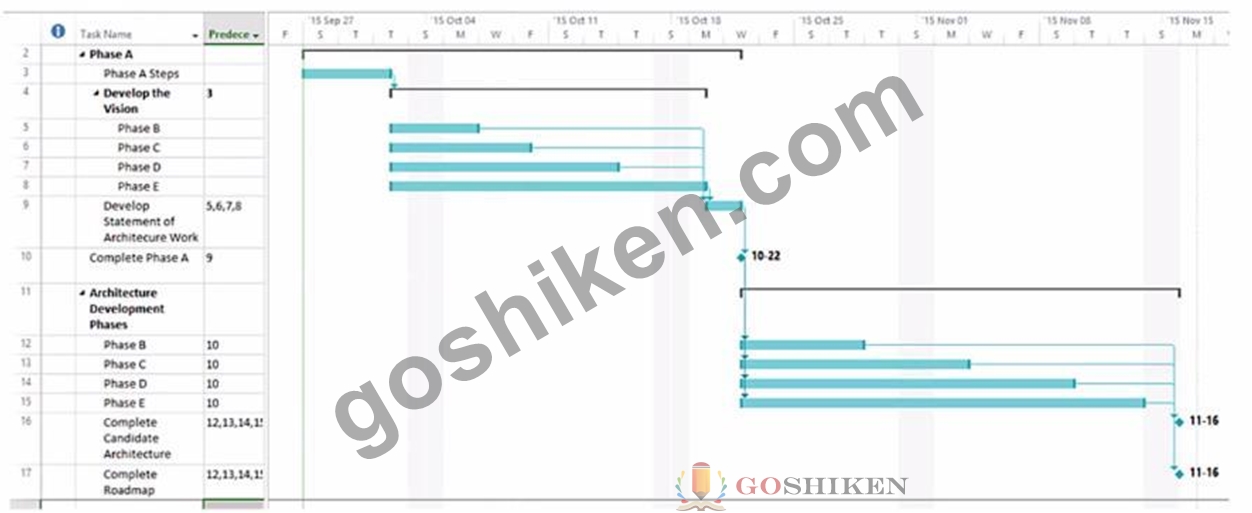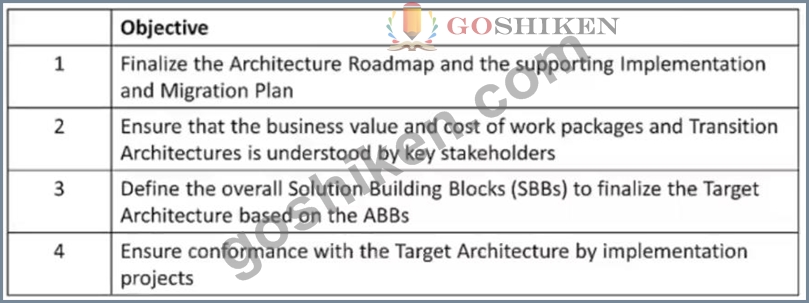無料でクラウドストレージから最新のGoShiken OGEA-103 PDFダンプをダウンロードする:https://drive.google.com/open?id=1aDIO-3jQPQrKtnaTgvtudCyHESJMPIq7
当社The Open GroupのOGEA-103学習教材は、試験に合格するための最高のOGEA-103試験トレントを提供するのに十分な自信を持っています。長年の実務経験により、市場の変化とニーズに迅速に対応しています。このようにして、最新のOGEA-103ガイドトレントがあります。市場動向に遅れずについていく方法について心配する必要はありません。 OGEA-103試験問題は、受験者がOGEA-103試験に合格するのに最も適していると言えます。後悔することはありません。
Open Group Architecture Framework(TOGAF)は、エンタープライズアーキテクチャに有名で広く採用されているフレームワークです。エンタープライズアーキテクチャの設計、計画、実装、および管理への包括的なアプローチを提供します。 TOGAF認定は、エンタープライズアーキテクチャの分野の専門家によって非常に価値があり、求められています。オープングループは、TOGAFエンタープライズアーキテクチャ認証のパート1とパート2を組み合わせたOGEA-103試験を含むいくつかのレベルの認証を提供します。
OGEA-103試験の準備方法|一番優秀なOGEA-103関連合格問題試験|有効的なTOGAF Enterprise Architecture Combined Part 1 and Part 2 Exam日本語版テキスト内容
進歩を遂げ、OGEA-103トレーニング資料の証明書を取得することは、当然のことながら、最新の最も正確な知識を指揮する最も専門的な専門家によるものです。それが、TOGAF Enterprise Architecture Combined Part 1 and Part 2 Exam試験準備が市場の大部分を占める理由です。それに、OGEA-103練習教材の利益を待つのではなく、支払い後すぐにダウンロードできるので、今すぐ成功への旅を始めましょう。
オープングループは、情報技術のオープンスタンダードとベストプラクティスを促進することを目的としたグローバルなコンソーシアムです。主力プログラムの1つは、Enterprise Architectsのベンチマークとして世界中で認識されているTogaf Enterprise Architecture Certificationです。 OGEA-103試験は、TOGAF認定のパート1とパート2の試験を組み合わせたOpen Groupの最新製品です。この試験は、エンタープライズアーキテクチャの知識とスキルを実証し、専門知識を認識したい専門家向けに設計されています。
The Open Group TOGAF Enterprise Architecture Combined Part 1 and Part 2 Exam 認定 OGEA-103 試験問題 (Q17-Q22):
質問 # 17
Please read this scenario prior to answering the question
Your role is that of a consultant to the Lead Enterprise Architect to an international supplier of engineering services and automated manufacturing systems. It has three manufacturing plants where it assembles both standard and customized products for industrial production automation. Each of these plants has been operating its own planning and production scheduling systems, as well as applications and control systems that drive the automated production line.
The Enterprise Architecture department has been operating for several years and has mature, well-developed architecture governance and development processes that are based on the TOGAF Standard. The CIO sponsors the Enterprise Architecture.
During a recent management meeting, a senior Vice-President highlighted an interview where a competitor company's CIO is reported as saying that their production efficiency had been improved by replacing multiple planning and scheduling systems with a common Enterprise Resource Planning (ERP) system located in a central data center. Some discussion followed, with the CIO responding that the situations are not comparable, and the current architecture is already optimized.
In response, the Architecture Board approved a Request for Architecture Work covering the investigations to determine if such an architecture transformation would lead to improvements in efficiency. You have been assigned to support the architecture team working on this project.
A well-known concern of the plant managers is about the security and reliability of driving their planning and production scheduling from a remote centralized system. Any chosen system would also need to support the current supply chain network consisting of local partners at each of the plants.
Refer to the scenario
You have been asked to explain how you will initiate the architecture project.
Based on the TOGAF Standard, which of the following is the best answer?
- A. You would research vendor literature and conduct a series of briefings with vendors that are on the current approved supplier list. Based on the findings from the research, you would define a preliminary Architecture Vision including summary views, high-level requirements, and high-level definitions of the baseline and target environments from a business, information systems, and technology perspective. You would then use that to build consensus among the key stakeholders.
- B. You would hold a series of interviews at each of the manufacturing plants using the business scenarios technique. This will allow you to understand the systems and integrations with local partners. You would use stakeholder analysis to identify key players in the engagement, and to understand their concerns. You will then identify and document the key high-level stakeholder requirements for the architecture. You will then generate high level definitions of the baseline and target architectures.
- C. You would develop baseline and target Architectures for each of the manufacturing plants, ensuring that the views corresponding to selected viewpoints address key concerns of the stakeholders. A business case, together with performance metrics and measures should be defined to ensure the architecture meets the business needs. A consolidated gap analysis between the architectures will then validate the approach and determine the capability increments needed to achieve the target state.
- D. You would conduct a pilot project that will enable vendors to demonstrate potential off-the-shelf solutions that address the concerns of the stakeholders. Running a pilot project will save time and money later in the process. Based on the findings of that pilot project, a complete set of requirements can then be developed that will drive the evolution of the architecture. Once the requirements are completed, a formal stakeholder review should be held, and permission sought to proceed to develop the target architecture.
正解:B
解説:
The best answer is C. You would hold a series of interviews at each of the manufacturing plants using the business scenarios technique. This will allow you to understand the systems and integrations with local partners. You would use stakeholder analysis to identify key players in the engagement, and to understand their concerns. You will then identify and document the key high-level stakeholder requirements for the architecture. You will then generate high level definitions of the baseline and target architectures.
This answer is based on the TOGAF standard, which recommends the following steps to initiate the architecture project1:
* Establish the architecture project
* Identify stakeholders, concerns, and business requirements
* Confirm and elaborate business goals, business drivers, and constraints
* Evaluate business capabilities
* Assess readiness for business transformation
* Define scope
* Confirm and elaborate Architecture Principles, including business principles
* Develop Architecture Vision
* Define the Target Architecture value propositions and KPIs
* Identify the business transformation risks and mitigation activities
* Secure stakeholder and sponsor approval
The answer C covers most of these steps, by using the business scenarios technique to elicit and validate the business requirements, goals, drivers, and constraints, as well as the current and future states of the architecture2. The answer C also uses stakeholder analysis to identify and engage the key stakeholders, and to address their concerns and expectations3. The answer C also generates high level definitions of the baseline and target architectures, which can be used to develop the Architecture Vision and the value propositions4.
The other answers are not the best approach for architecture development, because:
* Answer A focuses on researching vendor literature and conducting briefings with vendors, which is not the best way to understand the business needs and the current situation of the enterprise. Answer A also defines a preliminary Architecture Vision without involving the stakeholders or validating the
* requirements, which may lead to misalignment and lack of consensus.
* Answer B conducts a pilot project that will enable vendors to demonstrate potential solutions, which is premature and costly at this stage of the architecture project. Answer B also does not address the stakeholder concerns or the current systems and integrations, which may result in gaps and risks.
Answer B also develops the requirements after the pilot project, which may not reflect the actual business needs and goals.
* Answer D develops baseline and target architectures for each of the manufacturing plants, which may not consider the enterprise-wide perspective and the potential benefits of a common ERP system.
Answer D also does not involve the stakeholders or address their concerns, which may result in resistance and conflict. Answer D also does not define the business case or the performance metrics, which are essential for demonstrating the value and feasibility of the architecture.
References: 1: The TOGAF Standard, Version 9.2 - Architecture Vision 2: The TOGAF Standard, Version 9.2
- Business Scenarios 3: [The TOGAF Standard, Version 9.2 - Stakeholder Management] 4: [The TOGAF Standard, Version 9.2 - Architecture Definition Document]
質問 # 18
Consider the following ADM phases objectives.
Objective:
1.Develop the Target Data Architecture that enables the Business Architecture and the Architecture Vision
2.Develop the Target Business Architecture that describes how the enterprise needs to operate to achieve the business goals
3.Develop a high-level aspirational vision of the capabilities and business value to be delivered as a result of the proposed Enterprise Architecture
4.Identify candidate Architecture Roadmap components based upon gaps between the Baseline and Target Technology Architectures Which phase does each objective match?
- A. 1A-2B-3C-4D
- B. 1B-2D-3A-4C
- C. 1C-2D-3B-4A
- D. 1C-2B-3A-4D
正解:D
解説:
*Phase A: Architecture Vision
oDevelop a high-level aspirational vision of the capabilities and business value to be delivered as a result of the proposed Enterprise Architecture oDefine the scope and boundaries of the architecture engagement oIdentify the key stakeholders and their concerns and expectations oDefine the Architecture Vision statement and the Architecture Definition Document oObtain approval and commitment from the sponsors and stakeholders
*Phase B: Business Architecture
oDevelop the Target Business Architecture that describes how the enterprise needs to operate to achieve the business goals oDefine the Baseline Business Architecture, if not available oPerform a gap analysis between the Baseline and Target Business Architectures oDefine candidate roadmap components for the Business Architecture oResolve impacts across the Architecture Landscape
*Phase C: Information Systems Architecture
oDevelop the Target Data Architecture that enables the Business Architecture and the Architecture Vision oDevelop the Target Application Architecture that supports the Business Architecture and the Architecture Vision oDefine the Baseline Data and Application Architectures, if not available oPerform a gap analysis between the Baseline and Target Data and Application Architectures oDefine candidate roadmap components for the Information Systems Architecture oResolve impacts across the Architecture Landscape
*Phase D: Technology Architecture
oDevelop the Target Technology Architecture that enables the Information Systems Architecture and the Architecture Vision oDefine the Baseline Technology Architecture, if not available oPerform a gap analysis between the Baseline and Target Technology Architectures oIdentify candidate Architecture Roadmap components based upon gaps between the Baseline and Target Technology Architectures oResolve impacts across the Architecture Landscape Therefore, the correct matching of the objectives and the phases is:
*1C: Develop the Target Data Architecture that enables the Business Architecture and the Architecture Vision
*2B: Develop the Target Business Architecture that describes how the enterprise needs to operate to achieve the business goals
*3A: Develop a high-level aspirational vision of the capabilities and business value to be delivered as a result of the proposed Enterprise Architecture
*4D: Identify candidate Architecture Roadmap components based upon gaps between the Baseline and Target Technology Architectures References: 1: The TOGAF Architecture Development Method
質問 # 19
Consider the following chart:
Which important concept for Enterprise Architecture Practitioners does it illustrate?
- A. Enterprise Architects must use Gantt charts to communicate with Stakeholders.
- B. An Enterprise Architecture must be developed in phases with a limited fixed duration.
- C. ADM phases must be run in a sequenced approach to produce the Architecture.
- D. ADM phases must be run simultaneously until the relevant information has been produced.
正解:B
解説:
Explanation
https://pubs.opengroup.org/architecture/togaf8-doc/arch/chap03.html
The chart that you have provided is a Gantt chart that shows the tasks and timelines of a TOGAF project. It illustrates the concept of phased development of an Enterprise Architecture, which is one of the key principles of the TOGAF Architecture Development Method (ADM). The ADM is a cyclic process that consists of nine phases, from Preliminary to Architecture Change Management1. Each phase has a specific purpose, scope, inputs, steps, and outputs, and produces a part of the Enterprise Architecture. The phases are executed in a sequential order, with some iterations and feedback loops, to ensure that the architecture is consistent, complete, and aligned with the business requirements and objectives. The phases also have a limited fixed duration, which is determined by the complexity, scope, and resources of the project. This helps to manage the expectations, risks, and costs of the architecture development, and to deliver the architecture in a timely and effective manner23.
質問 # 20
Consider the following statement:
Separate projects may operate their own ADM cycles concurrently, with relationships between the different projects What does it illustrate?
- A. Iteration
- B. Requirements management
- C. Enterprise Architecture
- D. Implementation governance
正解:A
解説:
The statement illustrates iteration and the ADM. Iteration is the technique of repeating a process or a phase with the aim of improving or refining the outcome. Iteration allows for feedback loops and adaptations at any point in the architecture development and transition process. Separate projects may operate their own ADM cycles concurrently, with relationships between the different projects, to address different aspects or levels of the architecture in an iterative manner. Reference: The TOGAF Standard | The Open Group Website, Section 3.1 Introduction to the ADM.
質問 # 21
Consider the following ADM phases objectives.
Which phase does each objective match?
- A. 1F-2F-3E-4G
- B. 1F-2G-3F-4F
- C. 1E-2F-3E-4G
- D. 1G-2E-3F-4E
正解:C
解説:
1E: To identify delivery vehicles (projects programs portfolios) that will deliver the Target Architecture 2F: To confirm readiness and ability to undergo change 3E: To determine whether an incremental approach is required and if so identify Transition Architectures that will deliver continuous business value 4G: To perform appropriate governance functions while the solution is being implemented
質問 # 22
......
OGEA-103日本語版テキスト内容: https://www.goshiken.com/TheOpenGroup/OGEA-103-mondaishu.html
- 試験の準備方法-実用的なOGEA-103関連合格問題試験-効率的なOGEA-103日本語版テキスト内容 ℹ 最新▶ OGEA-103 ◀問題集ファイルは[ www.goshiken.com ]にて検索OGEA-103模擬資料
- OGEA-103更新版 🎩 OGEA-103認定試験トレーリング 🔱 OGEA-103資格認定 🟪 今すぐ《 www.goshiken.com 》を開き、⏩ OGEA-103 ⏪を検索して無料でダウンロードしてくださいOGEA-103無料模擬試験
- OGEA-103復習資料 📺 OGEA-103日本語版復習資料 🐅 OGEA-103無料模擬試験 🔦 サイト▛ www.goshiken.com ▟で【 OGEA-103 】問題集をダウンロードOGEA-103基礎訓練
- The Open Group OGEA-103関連合格問題: TOGAF Enterprise Architecture Combined Part 1 and Part 2 Exam - GoShiken 認定トレーニングを提供する権威の会社 🤍 ウェブサイト{ www.goshiken.com }を開き、{ OGEA-103 }を検索して無料でダウンロードしてくださいOGEA-103資格認定
- OGEA-103資格認定 🏰 OGEA-103資格問題対応 🧧 OGEA-103受験方法 🚮 Open Webサイト☀ www.goshiken.com ️☀️検索➥ OGEA-103 🡄無料ダウンロードOGEA-103日本語版受験参考書
- OGEA-103日本語版復習資料 🔓 OGEA-103更新版 🧡 OGEA-103日本語版復習資料 🍿 ➽ www.goshiken.com 🢪に移動し、[ OGEA-103 ]を検索して無料でダウンロードしてくださいOGEA-103資格問題対応
- OGEA-103無料模擬試験 🐈 OGEA-103更新版 🥁 OGEA-103更新版 🪕 ➽ www.goshiken.com 🢪には無料の【 OGEA-103 】問題集がありますOGEA-103日本語版復習資料
- OGEA-103試験勉強過去問 🧃 OGEA-103試験勉強過去問 🎲 OGEA-103学習関連題 😱 今すぐ▛ www.goshiken.com ▟を開き、{ OGEA-103 }を検索して無料でダウンロードしてくださいOGEA-103受験方法
- 高品質なOGEA-103関連合格問題一回合格-効果的なOGEA-103日本語版テキスト内容 🍊 今すぐ➤ www.goshiken.com ⮘で▷ OGEA-103 ◁を検索し、無料でダウンロードしてくださいOGEA-103更新版
- 試験の準備方法-実用的なOGEA-103関連合格問題試験-効率的なOGEA-103日本語版テキスト内容 ⛑ 「 www.goshiken.com 」を開いて▛ OGEA-103 ▟を検索し、試験資料を無料でダウンロードしてくださいOGEA-103 PDF
- OGEA-103試験勉強過去問 🪁 OGEA-103資格トレーニング 👮 OGEA-103学習関連題 🚾 ➥ www.goshiken.com 🡄は、⏩ OGEA-103 ⏪を無料でダウンロードするのに最適なサイトですOGEA-103受験方法
P.S.GoShikenがGoogle Driveで共有している無料の2024 The Open Group OGEA-103ダンプ:https://drive.google.com/open?id=1aDIO-3jQPQrKtnaTgvtudCyHESJMPIq7
